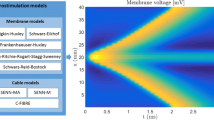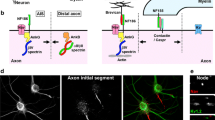Abstract
Nodes of Ranvier play critical roles in the generation and transmission of action potentials. Alterations in node properties during pathology and/or development are known to affect the speed and quality of electrical transmission. From a modelling standpoint, nodes of Ranvier are often described by systems of ordinary differential equations neglecting or greatly simplifying their geometric structure. These approaches fail to accurately describe how fine scale alteration in the node geometry or in myelin thickness in the paranode region will impact action potential generation and transmission. Here, we rely on a finite element approximation to describe the three dimensional geometry of a node of Ranvier. With this, we are able to investigate how sensitive is the electrical response to alterations in the myelin sheath and paranode geometry. We could in particular investigate irregular loss of myelin, which might be more physiologically relevant than the uniform loss often described through simpler modelling approaches.









Similar content being viewed by others
References
Adams RA, Fournier JJF (2003) Sobolev spaces. Pure and applied mathematics, vol 140. Academic Press, New York, London
Arancibia-Carcamo IL, Attwell D (2014) The node of Ranvier in CNS pathology. Acta Neuropathol 128(2):161–175
Bathe K (1996) Finite element procedures. Prentice-Hall, New Jersey
Belhamadia Y, Fortin A, Bourgault Y (2014) On the performance of anisotropic mesh adaptation for scroll wave turbulence dynamics in reaction–diffusion systems. J Comput Appl Math 271:233–246
Boahen F, Doyon N (2020) Modelling dendritic spines with the finite element method, investigating the impact of geometry on electric and calcic responses. J Math Biol 81(2):517–547
Bois R, Fortin M, Fortin A (2012) A fully optimal anisotropic mesh adaptation method based on a hierarchical error estimator. Comput Methods Appl Mech Eng 209–212:12–27
Bolintineanu DS, Sayyed-Ahmad A, Davis HT, Kaznessis YN (2009) Poisson–Nernst–Planck models of nonequilibrium ion electrodiffusion through a protegrin transmembrane pore. PLOS Comput Biol 5(1):1–12
Boucher P-A, Joós B, Morris CE (2012) Coupled left-shift of Nav channels: modeling the Na+-loading and dysfunctional excitability of damaged axons. J Comput Neurosci 33(2):301–319
Ciarlet P, Luneville E (2009) La méthode des éléments finis: de la théorie à la pratique. Concepts généraux. I. Cours (ENSTA). Les Presses de l’ENSTA
Dione I, Deteix J, Briffard T, Chamberland E, Doyon N (2016) Improved simulation of electrodiffusion in the node of Ranvier by mesh adaptation. PLoS ONE 11(8):e0161318
Dione I, Doyon N, Deteix J (2019) Sensitivity analysis of the Poisson Nernst–Planck equations: a finite element approximation for the sensitive analysis of an electrodiffusion model. J Math Biol 78(1):21–56
Gramse G, Dols-Perez A, Edwards MA, Fumagalli L, Gomila G (2013) Nanoscale measurement of the dielectric constant of supported lipid bilayers in aqueous solutions with electrostatic force microscopy. Biophys J 104(6):1257–1262
Hairer E, Nørsett SP, Wanner G (1993) Solving ordinary differential equations I (2nd Revised. Ed.): nonstiff problems, Revised. Springer-Verlag, New York
Hille B (1992) Ionic channels of excitable membranes. Sinauer Associates, Sunderland
Hodgkin AL, Huxley AF (1952) A quantitative description of membrane current and its application to conduction and excitation in nerve. J Physiol 117(4):500–544
Lopreore CL, Bartol TM, Coggan JS, Keller DX, Sosinsky GE, Ellisman MH, Sejnowski TJ (2008) Computational modeling of three-dimensional electrodiffusion in biological systems: application to the node of Ranvier. Biophys J 95(6):2624–2635
Lu B, Holst MJ, McCammon JA, Zhou Y (2010) Poisson–Nernst–Planck equations for simulating biomolecular diffusion–reaction processes I: finite element solutions. J Comput Phys 229(19):6979–6994
Peters A (1961) A radial component of central myelin sheaths. J Biophys Biochem Cytol 11(3):733–5
Pods J, Schonke J, Bastian P (2013) Electrodiffusion models of neurons and extracellular space using the Poisson–Nernst–Planck equations—numerical simulation of the intra- and extracellular potential for an axon model. Biophys J 105(1):242–254
Qian N, Sejnowski T (1989) An electro-diffusion model for computing membrane potentials and ionic concentrations in branching dendrites, spines and axons. Biol Cybern 62:1–15
Quarteroni AM, Valli A (2008) Numerical approximation of partial differential equations. Springer, Cham
Rosenbluth J, Nave K, Mierzwa A, Schiff R (2006) Subtle myelin defects in PLP-null mice. Glia 54(3):172–82
Stadelmann C, Timmler S, Barrantes-Freer A, Simons M (2019) Myelin in the central nervous system: structure, function, and pathology. Physiol Rev 99(3):1381–1431
Susuki K (2013) Node of Ranvier disruption as a cause of neurological diseases. ASN Neuro 5(3):209–19
Sylantyev S, Savtchenko L, Ermolyuk Y, Michaluk P, Rusakov D (2013) Spike-driven glutamate electrodiffusion triggers synaptic potentiation via a homer-dependent mGluR-NMDAR link. Neuron 77(3):528–541
Tora A, Rovira X, Dione I, Bertrand H, Brabet I, De Koninck Y, Doyon N, Pin J, Acher F, Goudet C (2015) Allosteric modulation of metabotropic glutamate receptors by chloride ions. FASEB J 29(10):4174–4188
Volman V, Ng LJ (2014) Primary paranode demyelination modulates slowly developing axonal depolarization in a model of axonal injury. J Comput Neurosci 37(3):439–57
Author information
Authors and Affiliations
Corresponding author
Additional information
Publisher's Note
Springer Nature remains neutral with regard to jurisdictional claims in published maps and institutional affiliations.
Jean Deteix and Nicolas Doyon are supported by the Natural Sciences and Engineering Research Council of Canada (http://www.nserc-crsng.gc.ca/).
Supplementary Information
Below is the link to the electronic supplementary material.
Appendices
A Discrete version of the Poisson Nernst–Planck equations
We denote by \(L^{2}(\Omega )\) the space of square integrable functions defined on \(\Omega \). The Sobolev spaces \(H^{m}(\Omega )\), \(m \ge 0\), are the spaces of functions in \(L^{2}(\Omega )\) with generalized partial derivatives belonging to \(L^{2}(\Omega )\) up to order m (see Adams and Fournier 2003). The functional space \(U_V\) containing the ionic concentrations and electric potential is defined as
1.1 A.1 Weak formulation of the Poisson Nernst–Planck equations
Multiplying the system of Eq. (1) by test functions \(v, w \in H^{1}(\Omega )\) and integrating over the domain \(\Omega \), we obtain the following weak formulation
Integrating by parts and taking into account (2), (4) and (5) we have \(\forall v,w \in V\),
Since
taking into account (6) and introducing \({\tilde{D}}_{i} = D_{i}/\lambda _{i}\) we obtain the weak problem: find \(c_{i} \in U_V\), \(i = 1,\ldots , n_c\) and \(\phi \in U_V\) such that
1.2 A.2 Numerical approximations
In order to numerically approximate solutions of (9) we introduce a time discrete formulation based on a finite difference time scheme and combine it with the finite element method for the spatial approximation. We consider a second order backward difference formula with, for convenience and simplicity, a constant time-step \(\Delta t\). Denoting \(t^n = n\Delta t\) and \(\psi ^n = \psi (\cdot ,t^n)\), the time derivative of \(\psi \) at time \(t^{n+1}\) is approximated by
The first timestep being calculated using a backward Euler approximation.
For the spatial approximation, the finite element method is used. First, we introduce a mesh \({\mathcal {T}}_{h} = \{\top \}\) of simplicial \(\top \) partitioning \(\Omega \):
with the usual restrictions on \({\mathcal {T}}_{h}\) (see Bathe 1996 or Ciarlet and Luneville 2009 for details). From the family \({\mathcal {T}}_{h}\) of triangulations of the domain \(\Omega \) (indexed by h), we construct the family of finite dimensional vector spaces \(V_{h}\). This set of standard continuous and piecewise functions is defined by
where \({\mathscr {P}}_{k}(\top )\) is the space of polynomials of degree less or equal to k on \(\top \). An index "h" is used to denote a spatial approximation in \(V_h\). An approximation, in \(V_h\), of \(\psi \) at time \(t^n\) will be noted \(\psi ^n_h\).
Since an implicit time scheme is used for an approximation at time \(t^{n+1}\), all terms (apart form the time derivatives) will be expressed at time \(t^{n+1}\). Applied on (9), this results in sequences of strongly coupled (and possibly non linear) problems characterizing time-discrete unknown (ionic concentrations, electric potential, etc.). Details for the resolution of these non linear systems and the resulting algorithm, are presented in Dione et al. (2016).
1.3 A.3 Discrete formulation of the PN–P equations
To simplify the notation, let
The implicit time scheme and finite element method applied on (9) produce a sequence of problems: for \(n \ge 1\), given \(c^{n-1}_{ih}\), \(c^{n}_{ih}\),\(\;\;i=1,\ldots ,n_c\), \(\phi ^{n-1}_{h}\) and \(\phi ^{n}_{h}\), find \(c^{n+1}_{ih} \in V_{h}\) and \(\phi ^{n+1}_{h} \in V_{h}\) such that
where \(\Gamma _h\) is the discrete version of the internal interface \(\Gamma \). These systems are non linear, since they contain \({\tilde{D}}_{i}c^{n+1}_{ih}\nabla \phi ^{n+1}_{h}\), moreover, the right-hand side \(f_{ih}^{n+1}\), a priori, depends on \(c_{ih}^{n+1}\). We use a Newton–Raphson method for solving (10) (which amount to a first order Taylor development of the non linear terms), the reader is refered to Dione et al. (2016) for the complete details.
B Voltage-gated channels
The functions \(n(t, \phi )\), \(m(t, \phi )\) and \(h(t, \phi )\) are time and voltage-dependent gating functions, taking values in [0, 1] defined by the following ODEs
where, denoting \(\phi _r\) the resting potential, the rate functions \(\alpha _{(\cdot )}\) and \(\beta _{(\cdot )}\) are defined by
We use the same rate functions as in Pods et al. (2013) (under the assumption that the temperature factor \(C_T\) is equal to 1) which are themselves equivalent to the rate functions used in Lopreore et al. (2008). The notation is however modified to describe the resting potential \(\phi _r\) as a parameter that could eventually vary and to give explicitly the value of the rate functions when the denominators are equal to zero. Computing the flux in (7) requires to solve the ODE system (11).
Rights and permissions
Springer Nature or its licensor (e.g. a society or other partner) holds exclusive rights to this article under a publishing agreement with the author(s) or other rightsholder(s); author self-archiving of the accepted manuscript version of this article is solely governed by the terms of such publishing agreement and applicable law.
About this article
Cite this article
Boahen, F., Doyon, N. & Deteix, J. Sensitivity of the electrical response of a node of Ranvier model to alterations of the myelin sheath geometry. J. Math. Biol. 86, 17 (2023). https://doi.org/10.1007/s00285-022-01841-0
Received:
Revised:
Accepted:
Published:
DOI: https://doi.org/10.1007/s00285-022-01841-0




